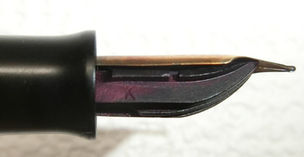top of page
Pelikan 100N (ca.1937) - the first generation
Green indicates the points that differ from Pelikan 100 (ca.1937).
Cap top; material: ebonite, shape: conical, inclined cap top edge, logo: old four chicks logo⁽¹⁾ on the top and “Pelikan Patent Pelikan Patent” on the lateral side.
Cap tube; material: ebonite, shape: 2 cap holes (one hole facing each other), two narrow bands, grooved at the level of vent holes around the inner wall.
Clip; shape: gold plated drop clip.
Nib; material: 14 ct gold, shape: round vent hole, logo:
Pelikan
585
14 KARAT
Feed; material: ebonite, shape: flat tail, three lamellae with the recess⁽²⁾.
Nib socket; material: ebonite, shape: 13.5 mm.
Grip section; material: ebonite, shape; inclined top edge, slightly tapered, step near the thread.
Barrel; material: transparent celluloid with brass ring.
Sleeve; material: celluloid.
Filling system; material: ebonite with cork seal, shape: conical, smooth turning knob without arrow.
Dimensions;
On March 25, 1937, the introduction of model 100N was announced. "N" stood for "neu (new)", as it was the successor of model 100. However, rather than replacing the predecessor, model 100N was produced concurrently for the export market. Please refer to the situations with the company and the world when model 100N was introduced (click).
Like model 100, Pelikan 100N can be categorized into "generations" by their production time, materials, and constructional characteristics. The first generation consists only of the first year version. I compared the first year Pelikan 100N (ca.1937) with Pelikan 100 (ca.1937). Please also refer to its another predecessor Pelikan Magnum (ca.1935).
-
Dimension; Model 100N is a bit larger than its predecessor 100. But, the length of the grip section and ink window are the same. Model 100N is about 3 mm longer and 0.5 mm thicker than 100, while it is 6 mm shorter and 0.5 mm thinner than Magnum.
-
Shape; Like model Magnum, the turning knob is conical. As a result, model 1ooN looks more streamlined than 100 to the tastes of the time (Pelikan Schreibgeräte).
-
Nib unit; As in Fig.5, the shape of 1ooN is different from that of 100. The nib of model 100N seems to have have wider shoulders and shorter slit (or tines) than that of 100⁽³⁾. They have the same logo as model 100. “Pelikan” imprint is the newer one that was revised in 1937, and “585” is the purity of gold based on millesimal fineness adopted in the same year. As in Fig.6, the feed tail of model 100N is flat, not slanted. The nib socket of model 100N is 1.5 mm longer than that of 100 (Fig.6).
-
Cap; Pelikan 100N has the same sealing and ventilating system as model 100. The cap top logo is old four chicks logo(1). So, the nib adopted new style while the cap top did old style.
-
Grip section and body; Like model Magnum, model 100N has a step on the grip section (Fig.5). Model 100N has the reinforcing ring on the barrel as model 100.
-
Filling system; Many constructional changes were made in the model 100N (Fig.8). 1) the shortened cone, 2) the notch on the piston guide that regulates the movement of the piston rod, 3) the screw-in cork seal stopper that securely fix the cork seal, 4) the arrow abolished on the turning knob, 5) The narrowed thread on the spindle.
So, model 100N was not mere an enlarged copy of 100, but the new model based on model 100 and with many new characteristics.
In the same year, model 101N characterized by colored cap and sleeve was introduced⁽⁴⁾. The lineup were as follows (cap / sleeve):
-
brown / tortoiseshell
-
tortoiseshell/ tortoiseshell
-
lizard / lizard
Short cap top models were also introduced this year⁽⁴⁾ (Pelikan Schreibgeräte)(Pelikan 100/100N short cap top).
Precious metal models were not yet introduced in the first year (Pelikan Schreibgeräte).
Note;⁽¹⁾Around 1937 , the cap top logo was replaced with new two chicks logo. "Pelikan" typography is also older one that was used from 1934 to 1937. So, old logo / typography tell that it was the first year version.
⁽²⁾The pen has the nib size specification on the feed (Fig.4). This is compatible with model 100, as model 100 for the domestic market had nib size on the cone (click).
⁽³⁾In my opinion, as a result of them, the nib of 100N are less flexible in general (click). I'm not sure if those changes were to the tastes of the time.
⁽⁴⁾They were destined for the export market, too.
bottom of page









